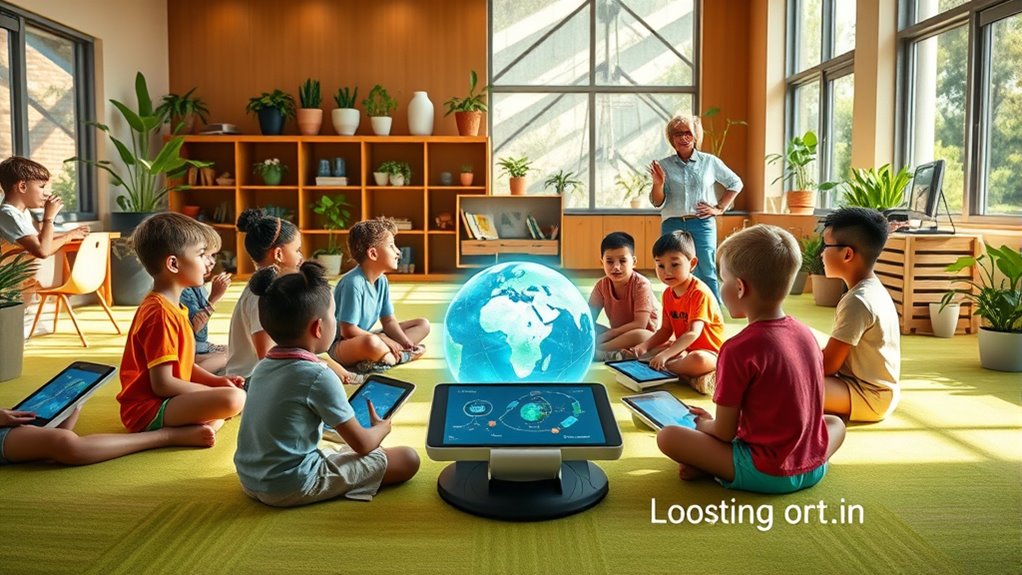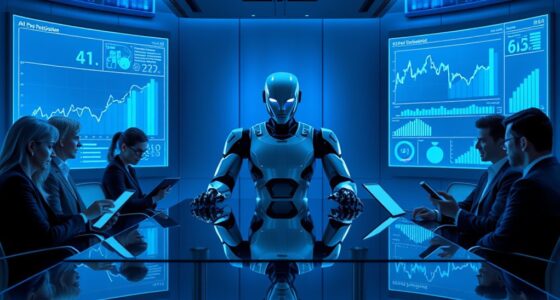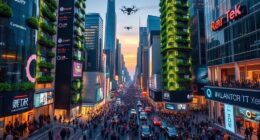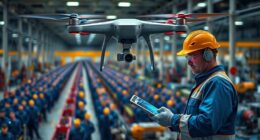To prepare for a future without traditional jobs, focus on developing adaptable skills like critical thinking, digital literacy, and emotional resilience. Embrace lifelong learning through innovative, technology-driven education that promotes flexibility and interdisciplinary knowledge. Prioritize inclusive and supportive environments that foster diversity and well-being. By combining these strategies, you’ll be better equipped for the changing workforce—if you continue exploring, you’ll discover even more ways to thrive in this evolving landscape.
Key Takeaways
- Emphasize skills-based learning and practical experience to prepare students for evolving, non-traditional career paths.
- Integrate digital platforms, AI, and immersive technologies to support lifelong, flexible education models.
- Focus on green and sustainable skills to meet future employment demands in renewable energy and environmental sectors.
- Foster adaptability, resilience, and emotional intelligence to thrive in dynamic, gig, and freelance work environments.
- Promote inclusive, equitable access to education and training to ensure diverse populations can participate in future economies.
Understanding the Shift Toward Skills-Based Employment
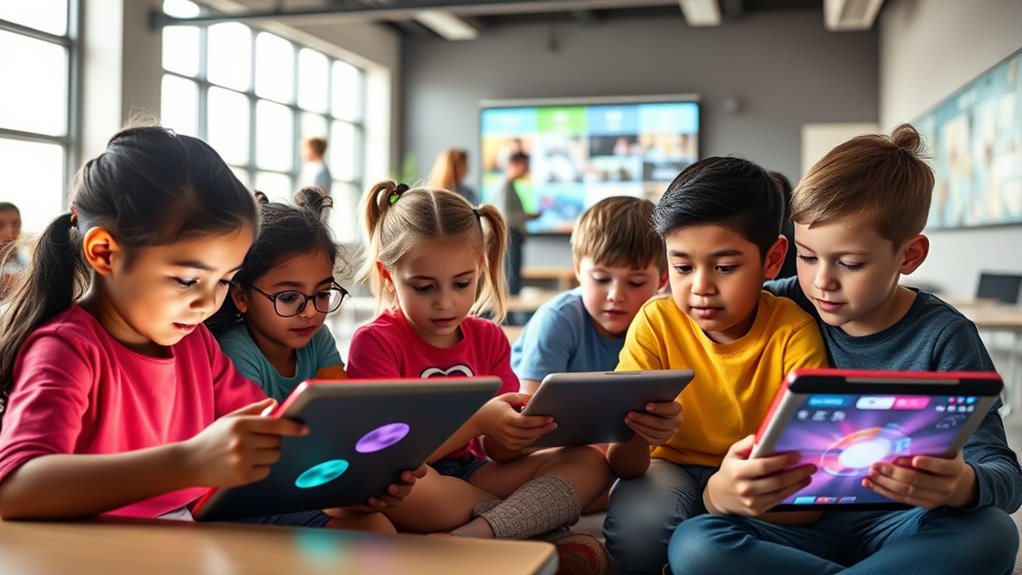
As the workforce evolves, more employers are prioritizing skills over traditional credentials. In 2024, 81% of companies used skills-based hiring, marking a sharp rise from previous years. By 2025, nearly half of organizations plan to eliminate degree requirements for key roles, focusing instead on proven competencies. This shift stems from widespread skills gaps, with 78% of survey respondents citing talent shortages as a top risk. Skills-based hiring isn’t just a trend; it’s shaping the future of work. Employers see it as a way to build diverse talent pools and improve employee retention—83% of workers stay longer when their organization emphasizes skills over formal education. Developing practical experience can significantly enhance your employability in this evolving job landscape. In addition, understanding skills gaps can help individuals identify which areas to develop to meet employer demands. Companies are increasingly valuing competency-based assessments as a reliable method for evaluating candidate capabilities, which underscores the importance of targeted skill development. If you want to succeed, focusing on developing your skills and practical experience becomes essential in this new job landscape. Incorporating essential oils into wellness routines can also support stress management and overall well-being, helping individuals perform at their best in a competitive job market, which is increasingly influenced by skills-based hiring practices.
Integrating Emerging Technologies Into Educational Frameworks
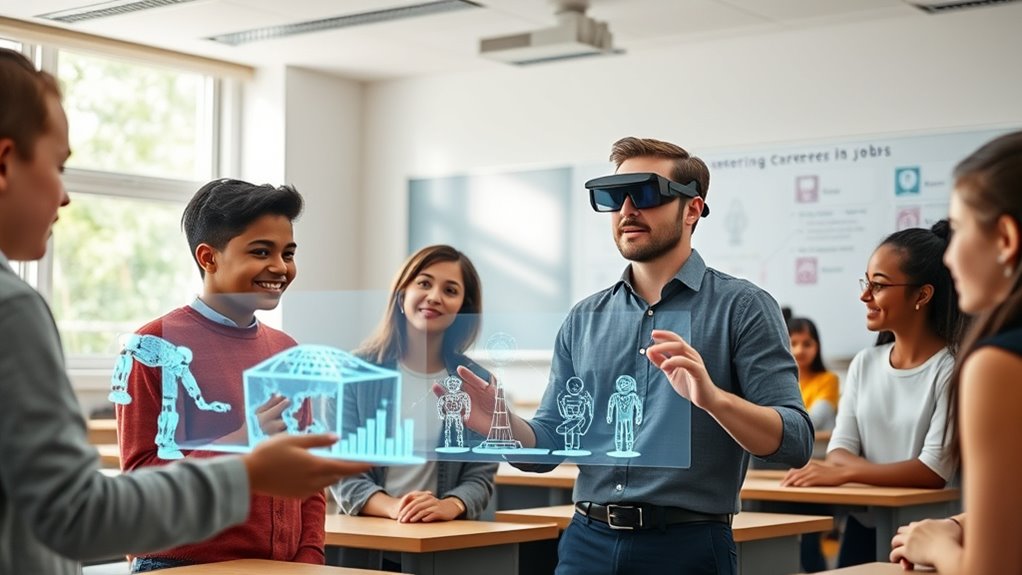
Integrating emerging technologies into educational frameworks is transforming how students learn and how institutions deliver instruction. Digital platforms now replace traditional campuses, offering flexible, accessible learning. AI adoption is rising, with 82% of college students using it, though high school usage remains lower. VR is increasingly employed, with institutions like Arizona State pioneering its use for immersive experiences. Technology enhances engagement—76% of students agree it improves learning—and supports data collection for personalized education. Additionally, understanding educational technology and its effective implementation is crucial for preparing students for a future shaped by technology. The integration of digital tools enables real-time feedback and adaptive learning environments that cater to individual student needs. Furthermore, leveraging educational data can help educators identify student progress and tailor instruction more effectively. Embracing technology integration is essential for modern education to stay relevant and effective. As educational institutions explore these innovations, fostering digital literacy among students becomes increasingly important to ensure they can navigate and utilize these tools effectively. To visualize this, consider the table:
| Idea | Impact |
|---|---|
| Digital Transformation | More flexible, online learning options |
| AI & Data | Personalized, efficient instruction |
| VR | Immersive, real-world simulations |
| Engagement & Support | Higher student satisfaction and accessibility |
Developing Lifelong Learning and Adaptive Competencies
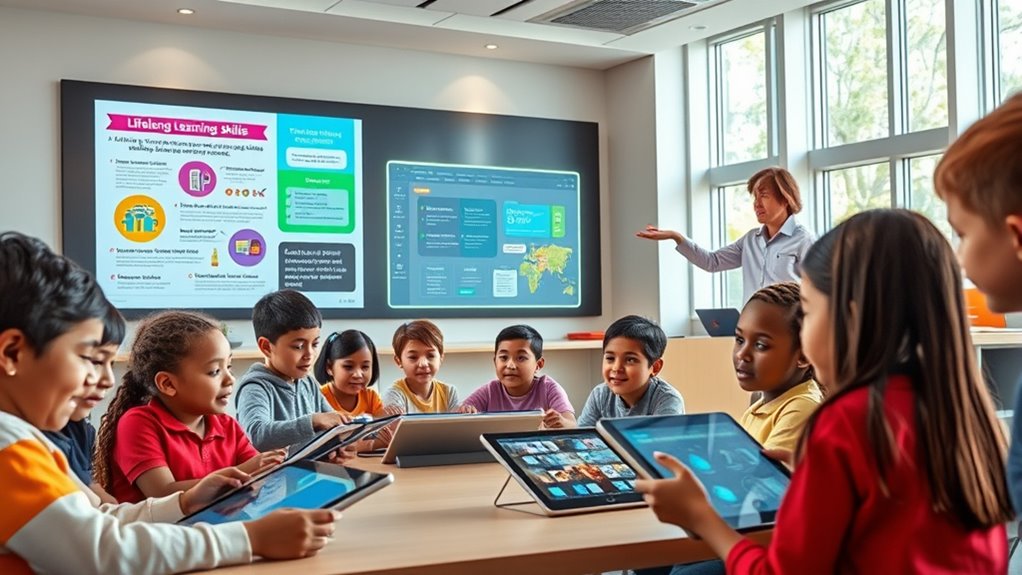
Developing lifelong learning and adaptive competencies is essential for preparing you to thrive in an ever-changing world. You need to embrace formal, nonformal, and informal learning methods that emphasize skills and competencies relevant to evolving demands. While much research remains theoretical, applying practical, mixed-method approaches can better develop these skills. Regional differences, teaching experience, and perceptions influence your ability to acquire lifelong learning competencies. Countries like Finland, Japan, and Sweden serve as models for fostering flexible skills through innovative strategies. Technology plays a crucial role, offering digital platforms, virtual reality, and data analytics to personalize and enhance learning. Additionally, understanding personality traits can help tailor learning approaches to individual needs, boosting adaptability. Recognizing size restrictions in your learning environment can also help optimize resource allocation and ensure compliance with educational standards. Incorporating health benefits of juice and other wellness strategies can support mental clarity and resilience, making learning more effective. Moreover, incorporating innovative teaching methods can further enhance engagement and retention. Developing cultural intelligence and cross-cultural skills is increasingly vital in a globalized world, ensuring your adaptability across diverse settings. By focusing on continuous development and adapting to new challenges, you’ll stay resilient and competitive in a future without traditional jobs.
Fostering Diversity, Inclusion, and Well-Being in Education
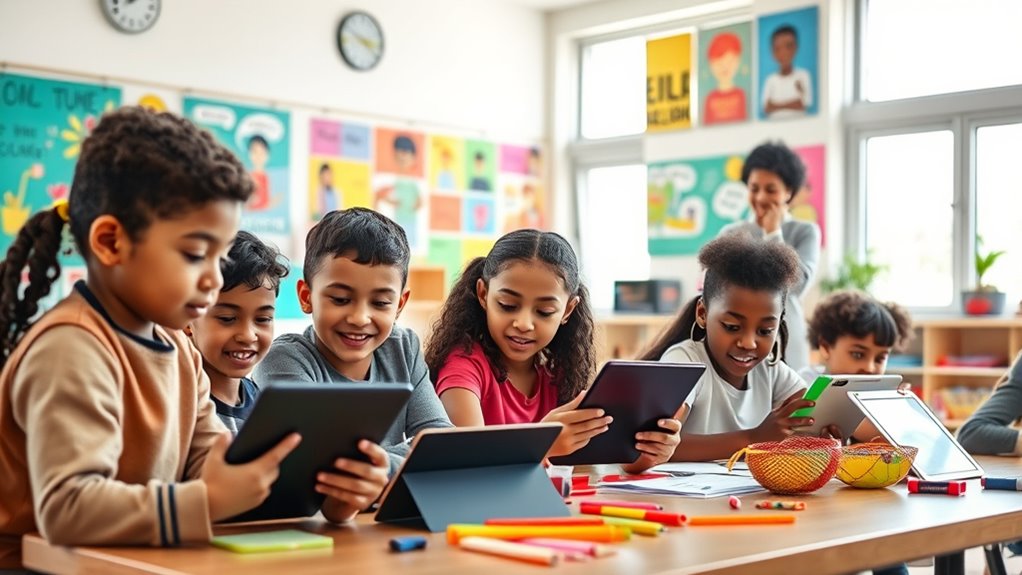
To foster true diversity, inclusion, and well-being, you need to focus on creating an inclusive curriculum that reflects multiple perspectives and experiences. Equitable access initiatives guarantee all students can participate fully, regardless of background. Supporting mental health is essential for cultivating safe, supportive learning environments where every student can thrive. Additionally, integrating creative practice into education encourages students to develop problem-solving and innovative skills vital for adapting to a future without traditional jobs. Recognizing the importance of economic factors, such as currency fluctuations, can also help prepare students to navigate the financial aspects of a globalized economy. Understanding the role of specialized equipment like vacuums can demonstrate how technological tools support various industries, inspiring students to explore diverse career paths. Incorporating STEM toys and hands-on learning experiences further enhances critical thinking and technical skills necessary for future employment. Emphasizing Making Money Online opportunities within the curriculum can also prepare students for diverse income streams beyond conventional employment.
Inclusive Curriculum Design
Creating an inclusive curriculum is essential for fostering diversity, promoting equity, and supporting the well-being of all students. You should incorporate diverse perspectives and materials that reflect students’ backgrounds, ensuring representation in content. Implement Universal Design for Learning to remove barriers and accommodate various learning needs, making education accessible for everyone. Incorporate feedback from students and community members to continually improve curriculum inclusivity, ensuring it remains relevant and respectful of evolving demographics. This ongoing process helps build a more equitable learning environment where every student feels valued. Incorporate ongoing cultural competence training for educators to better understand and meet students’ diverse needs. Incorporate best practices in educational equity to develop inclusive strategies that address systemic barriers. Integrate inclusive policies into laws and practices, and consider decolonizing curricula to promote fairness. Use diversified assessments and inclusive teaching methods tailored to a diverse student body. Address accessibility proactively, including mental health support and feedback mechanisms. The benefits include higher engagement, better retention, and the development of cultural competence. While challenges like resistance and resource constraints exist, leveraging technology and continuous feedback can help you create an equitable, inclusive learning environment. Additionally, applying a holistic SEO approach can enhance the visibility and reach of inclusive curricula by ensuring content relevance and accessibility for diverse audiences.
Equitable Access Initiatives
Equitable access initiatives are essential for ensuring that all students, regardless of background or socioeconomic status, can fully participate in education. These programs aim to break down barriers and promote fairness across educational systems. For example, South Korea’s Free Semester Program and SMART Education Initiative align learning with industry needs, boosting economic growth. Germany’s VET system offers practical skills for diverse students, supporting workforce development. The U.S. Department of Education’s Equity Action Plan invests heavily to address learning gaps and improve conditions. Additionally, over 23% of postsecondary institutions plan to implement equitable access programs by FY28. Key strategies include:
- Addressing barriers to college completion
- Implementing inclusive teaching practices
- Providing targeted scholarships
- Engaging diverse communities
Supporting Mental Health
Have you ever wondered how schools can better support students’ mental health while embracing diversity and inclusion? Nearly 60% of teens face mental health challenges like anxiety or depression, and digital learning can increase feelings of isolation. Schools are seeing more students seek mental health services, yet over half struggle to meet these needs due to limited resources and staff shortages. Supporting mental health requires culturally sensitive programs tailored to diverse backgrounds, ensuring all students feel seen and understood. Incorporating mindfulness, self-care, and mental health education into curricula can promote well-being. Collaboration with families and communities amplifies support, while digital tools and staff training help overcome barriers. Addressing stigma and expanding access are essential for nurturing resilient, inclusive learning environments. Utilizing specialized training and equipment like targeted programs can further enhance support systems for student mental health. Additionally, fostering a resilient mindset within students can empower them to navigate challenges more effectively.
Preparing Students for Green and Sustainable Careers
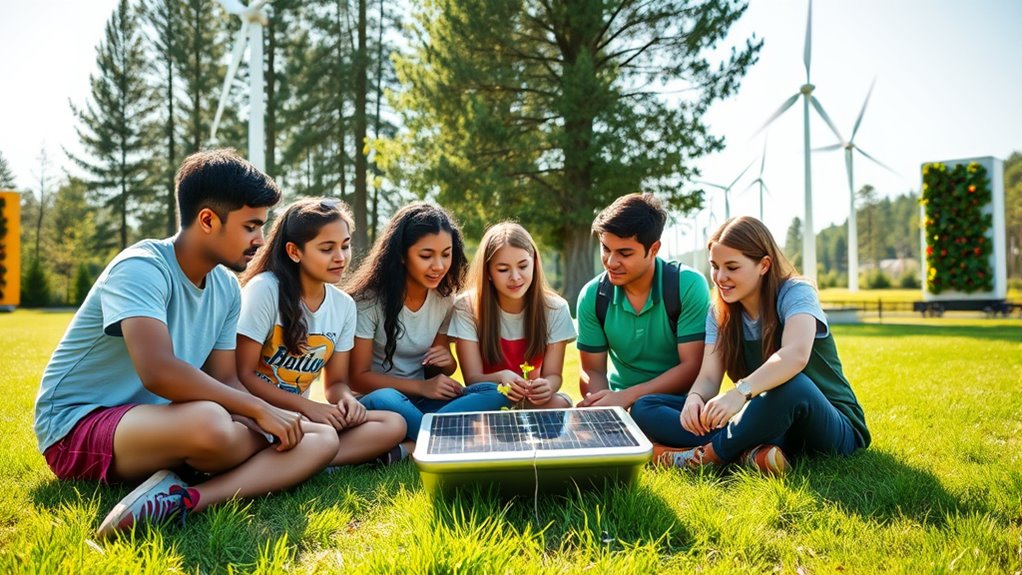
Are students truly prepared to meet the rapidly growing demand for green and sustainable careers? The green skills gap is widening, with vacancies projected to soar from 67 million in 2025 to 241 million by 2030. To bridge this gap, focus on these key areas:
The green skills gap is widening, with millions of jobs waiting to be filled by prepared, skilled students.
- Developing technical expertise in renewable energy systems like solar and wind.
- Gaining skills in carbon measurement, reporting, and sustainability planning.
- Building interdisciplinary knowledge in environmental science, engineering, and policy.
- Enhancing project management and communication abilities for sustainability initiatives.
Many students hesitate to showcase their green skills, risking underemployment. Meanwhile, governments often lag in providing adequate training, leaving businesses to upskill workers. Preparing students now guarantees they’re ready to fill critical roles in the evolving green economy.
Cultivating Flexibility and Resilience in Future Workforces

In today’s rapidly changing economic landscape, cultivating flexibility and resilience in the workforce is essential for maintaining competitiveness. You need to embrace adaptable hiring models and leverage dynamic workforce strategies that can shift in real-time with market conditions. Using freelancers helps fill skills gaps and keeps operations flexible. Technological tools like AI support creating a more responsive workforce capable of adjusting quickly. Resilience is equally vital; it enables you to manage change, reframe challenges, and seize opportunities amid uncertainty. Developing emotional energy management and making resilience core to workforce strategies strengthen performance under pressure. When combined with agility, resilience allows faster decision-making and better crisis management. These qualities ensure your organization remains competitive and capable of thriving in an unpredictable, volatile environment.
Rethinking Traditional Education Models for a Dynamic Labor Market
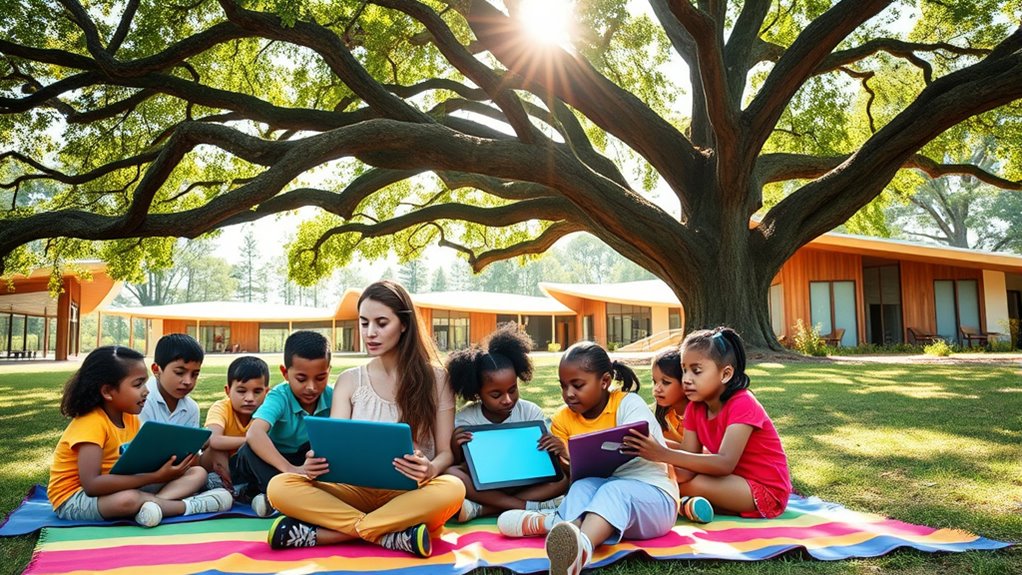
As the labor market evolves rapidly, traditional education models must adapt to prepare students effectively for changing industry demands. You need to balance technical specialization with broad skills that foster adaptability. To do this, focus on:
- Combining industry-specific skills with soft skills like critical thinking and communication.
- Promoting lifelong learning and continuous skill development beyond initial education.
- Strengthening public-private partnerships and alternative pathways like apprenticeships and vocational training.
- Incorporating technology and AI into curricula to prepare students for automated, AI-driven workplaces.
Frequently Asked Questions
How Will Global Economic Instability Influence Future Workforce Development Strategies?
You’ll need to adapt your workforce development strategies because global economic instability makes employers cautious about hiring. They’ll rely more on automation and technology to save costs, emphasizing continuous skill development and workforce agility. You should focus on reskilling initiatives, digital literacy, and flexible work models to stay competitive. With economic fluctuations, building a resilient, adaptable workforce becomes essential for steering through uncertainty and maintaining growth.
What Role Will Lifelong Learning Platforms Play in Accessible Education for All?
Imagine a world where barriers to education crumble, like walls tumbling down. Lifelong learning platforms become your bridge to opportunity, making education accessible regardless of location or background. With advancements like AI and microlearning, you can learn anytime, anywhere. You’re empowered to adapt swiftly to changing job landscapes, ensuring continuous growth. These platforms transform education from a privilege into a universal right, shaping a more inclusive, skilled future for all.
How Can Education Systems Effectively Address Skills Gaps in Underserved Communities?
You can address skills gaps in underserved communities by implementing inclusive education programs that focus on community engagement and policy reforms. Leverage technology to provide accessible learning resources and tailor interventions to local needs. Encourage parental involvement and support initiatives that promote literacy and basic skills. By adopting multifaceted strategies, you help guarantee every child gains the essential skills needed for future success, regardless of socioeconomic or geographic barriers.
What Ethical Considerations Arise With Increasing AI Integration in Education and Work?
You need to consider ethical issues like bias and fairness in AI systems, as they can reinforce existing inequalities. Protecting student data privacy is vital, along with establishing accountability for AI-driven decisions. Be mindful of widening access gaps and over-reliance on technology, which could hinder critical skills. Ensuring responsible AI use involves creating policies that promote fairness, transparency, and equal opportunity for all students and workers.
How Will Changing Immigration Policies Impact Talent Mobility and Workforce Diversity?
You might think stricter immigration policies limit talent mobility and reduce workforce diversity, but evidence suggests they can also push skilled workers elsewhere, harming innovation. When policies are flexible, you attract a broader range of talent, boosting economic growth and creativity. So, your approach to immigration directly impacts how diverse and adaptable your workforce remains, shaping the future of industries and the country’s global competitiveness.
Conclusion
As you shape the future of education, remember it’s your brushstroke on a vast canvas of change. Embrace innovation, cultivate adaptability, and foster inclusivity like a gardener tending to a diverse garden. By nurturing skills over static knowledge, you’re planting seeds for a resilient, green, and tech-savvy workforce ready to dance with the ever-changing rhythm of tomorrow’s world. Your role is the compass guiding this vibrant evolution—trust in the journey ahead.
